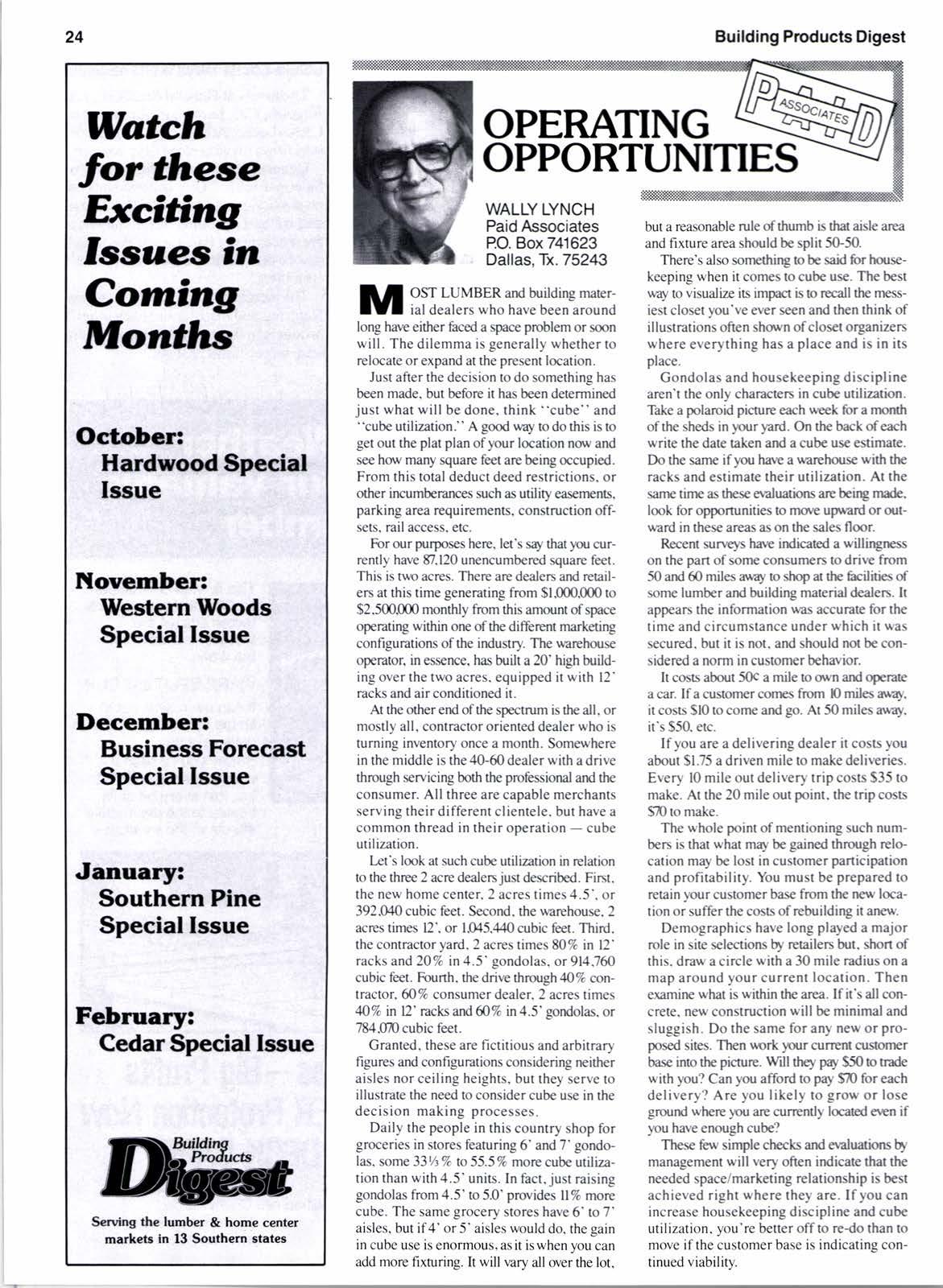
3 minute read
OPERANNG OPPORTUNITIES
WALLY LYNCH
Paid Associates
PO. Box 741623 Dallas, Tx.75243 llovember: Western Woodg Special Issue
OST LUMBER ard building material dealers who have been around long have either faced a spacc problem or soon will. The dilemma is generally whether to relocate or expand at the present location.
Just after the decision to do something has been made, but before it has been determined just what will be done. think "cube'' and "cube utilization." A good way to do this is to get out the plat plan ofyour location nov and see horv many square feet are being occupied. From this total deduct deed restrictions. or other irrcumberarrces such as utility easenrens, parking area requirements, construction offses. rail access. etc.
Deccmber: Business Forecast Special lgsue
January: $outhern Pine Special Issue
Febnrary: Cedar$pedd Issue
For our purposes here, let's sry that )ou currently have 87.120 unencumbered square feet. This is two acres. There are dealers and retailers at this time generating from $1,000.000 to $2.500.000 monthly from this amount of space operating within one of the different markaing configurations of the industry. The warehouse operator. in essence. has built a 20' high building over the two acres. equipped it with 12' rack and air conditioned it.
At the other end of the spectrum is the all. or mostly all, contractor oriented dealer who is turning inventory once a month. Somewhere in the middle is the 40-60 dealer with a drive through servicing both the proftssional and the consumer. All three are capable merchants serving their different clientele, but have a common thread in their operationcube utilization.
[rt's look at such cube utilization in relation to the three 2 acre dealersjust described. Fint. the new home center. 2 acres times 4.5'. or 392.(X0 cubic feet. Second. the warehouse. 2 acres times l2'. or 1.O15.440 cubic feet. Third. the contractor yard, 2 acres times 80% in 12' racks and 20% in4.5'gondolas. or 914.760 cubic feet. Fourth. the drive through zlo% contractor.60% consumer dealer. 2 acres times 40% n l2' rack ard 60% in 4.5' gondolas. or 784.OllD cubic feet.
Granted, these are fictitious and arbitrary figures and configurations considering neither aisles nor ceiling heights, but they serve to illustrate the need to consider cube use in the decision making processes.
Daily the people in this country shop for groceries in stores fearuring 6' and 7'gondolas. some 33t/t% to 55.5% more cube utilization than with 4.5' units. In fact, just raising gondolas from 4.5'to 5.0'provides llVo nrcre cube. The same grocery stores have 6' to 7' aisles, but if4' or 5' aisles would do, the gain in cube use is enormous. as it is when you can add more fixturing. It will vary all over the lot, but a reasonable rule of thumb is that aisle area and fixture area should be split 5050.
There's also sonrethirg to be sait for hourkeeping when it comes to cube use. The best way to visualize is impact is o recall the messiest closet you've ever seen and then think of illustrations often shovn ofcloset organizers where everything has a place and is in its place.
Gondolas and housekeeping discipline aren't the only characters in cube utilization. Tbke a polaroid picnrre each week for a rnonrh ofthe sheds in your yard. On the back ofeach write the date taken and a cube us€ estimate. Do the same if you harre a u,arehouse with the racks and estimate their utilization. At the sanre tinre as these evaluatiorc are being mde. look for opportunities to rnore upward or outward in these areas as on the sales floor.
Recent surveys twe irdicat€d a willirgness on the part of some consumen to drive from 50 ard 6O miles aurry to shop at Orc hcilities of some lumber and building material dealers. Il appears the information was accurate for the time and circumstance under which it was secured. but it is not. and should not be considered a norm in customer behavior.
It coss about 5Oc a mile to ovvn and operate a car. lf a cusomer cofircs frrom () miles auay. it coss $10 to come and go. At 5O miles auay. it's S50. etc.
Ifyou are a delivering dealer it costs you about 51.75 a driven mile to make deliveries. Every l0 mile out delivery trip costs S35 to make. At the 20 mile out point. the trip coss 5D to make-
The whole point of mentioning such numben is that what may be gained through relocation may be lost in customer participation and profitability. You must be prepared to retain your customer base fmm the ne* location or suffer the coss ofrebuilding it aneu Demographics have long played a major role in site selections by rctailers but. shon of this. draw a circle with a 30 mile radius on a map around your current location. Then examine what is within the area. If it's all concrete. new construction will be minimal and sluggish. Do the same for any new or proposed sites. Then uork )ourcurrentcuslorner base into tlre picture. Will Orcy pay tJO to trade with you? Can you afford to pay 510 for each delivery? Are you likely to grow or lose grourd where 1ou are currently located eren if you have enough cube?
Ttrcse few simple checks ard e€luations ry management will very often indicate that rhe needed space/marketing relationship is best achieved right where they are. Ifyou can increase housekeeping discipline and cube utilization, you're better off to reio than to move if the customer base is indicatins continued viability.

